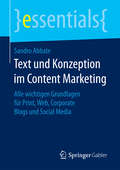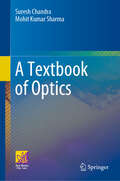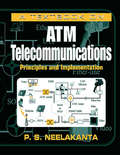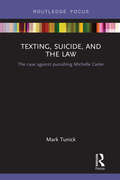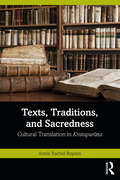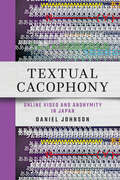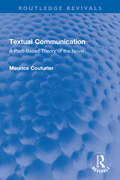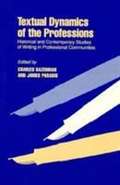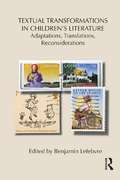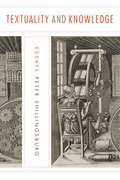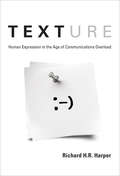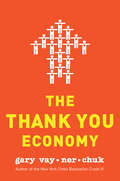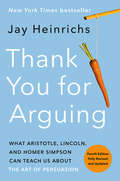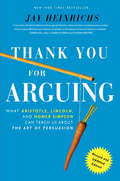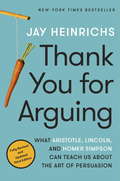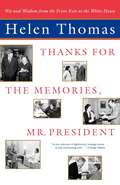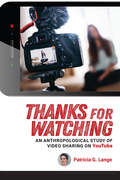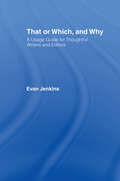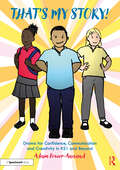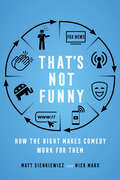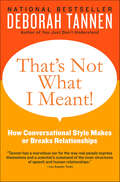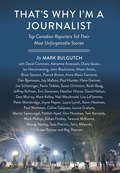- Table View
- List View
Text und Konzeption im Content Marketing: Alle wichtigen Grundlagen für Print, Web, Corporate Blogs und Social Media (essentials)
by Sandro AbbateIn diesem essential erfahren Sie alle wichtigen Grundlagen der Text- und Konzeptentwicklung f#65533;r eine Content-Marketing-Strategie. Der Autor beschreibt die erfolgsentscheidenden Stellschrauben, die Sie beachten m#65533;ssen und in die Sie ausreichend Zeit investieren sollten: von der vorab zu leistenden Denkarbeit, #65533;ber die strukturierte Konzeptentwicklung, bis hin zur optimalen Textarbeit f#65533;r Webtexte. Abgerundet wird dieser Band durch Interviews mit renommierten Experten und Erfolgsbeispielen aus der Praxis.
A Textbook of Optics
by Suresh Chandra Mohit Kumar SharmaThis book is designed to serve as a textbook for courses offered to upper-undergraduate students enrolled in physics and explains the broad spectrum of optics in a student-friendly way. The textbook covers the entire syllabi of the undergraduate courses being taught at both national and international universities including adequate details of mathematical expressions to help students understand the subject matter. The topics covered in this book are reflection, refraction, cardinal points, interference, Fresnel diffraction, Fraunhofer diffraction, lasers and holography, fiber optics, etc. This book explains each topic in a simple and lucid language with the help of solved problems. Exercises with multiple choice questions have been given at the end of each chapter for self-assessment. The detailed coverage and pedagogical tools make this an ideal textbook for students and researchers enrolled in senior undergraduate and beginning postgraduate physics students.
A Textbook on ATM Telecommunications: Principles and Implementation
by P. S. NeelakantaWith quantum leaps in science and technology occurring at breakneck speed, professionals in virtually every field face a daunting task-practicing their discipline while keeping abreast of new advances and applications in their filed. In no field is this more applicable than in the rapidly growing field of telecommunications engineering. Practicing engineers who work with ATM technology on a daily basis must not only keep their skill sharp in areas such as ATM network interfaces, protocols, and standards, but they must also stay informed, about new classes of ATM applications.A Textbook on ATM Telecommunications gives active telecommunications engineers the advantage they need to stay sharp in their field. From the very basics of ATM to state-of-the-art applications, it covers the gamut of topics related to this intriguing switching and multiplexing strategy. Starting with an introduction to telecommunications, this text combines the theory underlying broadband communications technology with applied practical instruction and lessons gleaned from industry. The author covers fundamental communications and network theory, followed by applied ATM networking. Each chapter includes design exercises as well as worked examples .A Textbook on ATM Telecommunications includes examples of design and implementation-making it an ideal took for both aspiring and practicing telecommunication professionals.Features
Texting, Suicide, and the Law: The case against punishing Michelle Carter
by Mark TunickIn 2014, Conrad Roy committed suicide following encouragement from his long-distance girlfriend, Michelle Carter, in what has become known as the Texting Suicide case. The case has attracted much attention, largely focusing on the First Amendment free speech issue. This book takes the view that the issue is intertwined with several others, some of which have received less attention but help explain why the case is so captivating and important, issues concerning privacy, accountability, coercion, punishment, and assisted suicide. The focus here is on how all of these issues are interconnected. By breaking the issue down into its complex layers, the work aids reasoned judgment, ensuring we aren’t guided solely by our gut reactions. The book is laid out as a case against punishing Ms. Carter, but it is less important that we agree with that conclusion than that we reach our conclusions not just through our instincts and intuitions but by thinking about these fundamental issues. The work will be of interest to scholars in law, political theory, and philosophy as an example of how theoretical issues apply to particular controversies. It will also appeal to readers interested in freedom of speech and the First Amendment, criminal justice and theories of punishment, suicide laws, and privacy.
Texts, Traditions, and Sacredness: Cultural Translation in Kristapurāṇa
by Annie Rachel RoysonThis book presents a critical reading of Kristapurāṇa, the first South Asian retelling of the Bible. In 1579, Thomas Stephens (1549–1619), a young Jesuit priest, arrived in Goa with the aim of preaching Christianity to the local subjects of the Portuguese colony. Kristapurāṇa (1616), a sweeping narrative with 10,962 verses, is his epic poetic retelling of the Christian Bible in the Marathi language. This fascinating text, which first appeared in Roman script, is also one of the earliest printed works in the subcontinent. Kristapurāṇa translated the entire biblical narrative into Marathi a century before Bible translation into South Asian languages began in earnest in Protestant missions. This book contributes to an understanding of translation as it was practiced in South Asia through its study of genre, landscapes, and cultural translation in Kristapurāṇa, while also retelling a history of sacred texts and biblical narratives in the region. It examines this understudied masterpiece of Christian writing from Goa in the early era of Catholic missions and examines themes such as the complexities of the colonial machinery, religious encounters, textual traditions, and multilingualism, providing insight into Portuguese Goa of the sixteenth and seventeenth centuries. The first of its kind, the book makes significant interventions into the current discourse on cultural translation and brings to the fore a hitherto understudied text. It will be an indispensable resource for students and researchers of translation studies, comparative literature, religious studies, biblical studies, English literature, cultural studies, literary history, postcolonial studies, and South Asian studies.
Textual Cacophony: Online Video and Anonymity in Japan
by Daniel JohnsonTextual Cacophony explores the behaviors and routines of communication within anonymous internet culture in Japan. Focusing on the video sharing website Niconico, social media aggregation sites, and the notorious 2channel message board, Daniel Johnson uncovers these sites' complex cultures of writing that obscure meaning through playful and opaque forms of deviant script and overwhelming waves of text. Those practices conflate language with images, meaning with play, and confound individual representation with aggregate forms of social identity. Johnson argues that online media cultures in and around Japan are entwined with a cultural logic and visual syntax of cacophony that expresses ambivalence toward representation, media form, and distinct experiences of time. This aesthetic of cacophony provides an alternative way of expressing social identity and belonging, with an unmarked sense of anonymity providing a counter-form to the dissolving institutions and relationships of neoliberal Japan. Textual Cacophony investigates what it means and feels like to participate in this influential online culture.
Textual Communication: A Print-Based Theory of the Novel (Routledge Revivals)
by Maurice CouturierFirst published in 1991, Textual Communication examines the character and development of the novel from Richardson to Nabokov in relation to the printing and publishing industry. The book blends literary theory with a historical analysis of communication, carrying the debate on the novel beyond the pioneering work of Booth and Genette, while responding to and taking issue with the writings of Foucault, Baudrillard, McLuhan, and Barthes. It analyses the structures of the industry which manufactured and marketed novels to show how novelists solved the communication problems that they faced in the eighteenth, nineteenth, and twentieth centuries. It also pinpoints critical moments in the history of the novel when new narrative strategies appeared, and places them in the context of the communication environment in which the texts were produced. Using Lacan’s theory of the divided subject, the book defines textual communication as a form of interaction in which two divided subjects, the author and the reader, try to communicate with each other under or against the law of the book market, censorship, literary conventions, and language.
Textual Dynamics of the Professions: Historical and Contemporary Studies of Writing in Professional Communities
by Charles Bazerman James ParadisTextual Dynamics of the Professions is a collection of fifteen essays examining the real effects of text on professional practices--in academic, scientific, and business settings. Charles Bazerman and James Paradis describe textual dynamics as an interaction in which professional texts and discourses are constructed by, and in turn construct, social practices. In the burgeoning field of discourse theory, this anthology stands apart in its treatment of a wide range of professional texts, including case studies, student papers, medieval letters, and product instructions, and in the inclusion of authors from a variety of disciplines. Invaluable to the new pedagogical field of "writing across the curriculum," Textual Dynamics of the Professions is also a significant intervention into the studies of rhetoric, writing theory, and the sociology of knowledge.
Textual Transformations in Children's Literature: Adaptations, Translations, Reconsiderations (Children's Literature and Culture #87)
by Benjamin LefebvreThis book offers new critical approaches for the study of adaptations, abridgments, translations, parodies, and mash-ups that occur internationally in contemporary children’s culture. It follows recent shifts in adaptation studies that call for a move beyond fidelity criticism, a paradigm that measures the success of an adaptation by the level of fidelity to the "original" text, toward a methodology that considers the adaptation to be always already in conversation with the adapted text. This book visits children’s literature and culture in order to consider the generic, pedagogical, and ideological underpinnings that drive both the process and the product. Focusing on novels as well as folktales, films, graphic novels, and anime, the authors consider the challenges inherent in transforming the work of authors such as William Shakespeare, Charles Perrault, L.M. Montgomery, Laura Ingalls Wilder, and A.A. Milne into new forms that are palatable for later audiences particularly when—for perceived ideological or political reasons—the textual transformation is not only unavoidable but entirely necessary. Contributors consider the challenges inherent in transforming stories and characters from one type of text to another, across genres, languages, and time, offering a range of new models that will inform future scholarship.
Textual Travels: Theory and Practice of Translation in India
by Mini Chandran Suchitra MathurThis book presents a comprehensive account of the theory and practice of translation in India in combining both its functional and literary aspects. It explores how the cultural politics of globalization is played out most powerfully in the realm of popular culture, and especially the role of translation in its practical facets, ranging from the fields of literature and publishing to media and sports.
Textuality and Knowledge: Essays (Penn State Series in the History of the Book #27)
by Peter ShillingsburgIn literary investigation all evidence is textual, dependent on preservation in material copies. Copies, however, are vulnerable to inadvertent and purposeful change. In this volume, Peter Shillingsburg explores the implications of this central concept of textual scholarship.Through thirteen essays, Shillingsburg argues that literary study depends on documents, the preservation of works, and textual replication, and he traces how this proposition affects understanding. He explains the consequences of textual knowledge (and ignorance) in teaching, reading, and research—and in the generous impulses behind the digitization of cultural documents. He also examines the ways in which facile assumptions about a text can lead one astray, discusses how differing international and cultural understandings of the importance of documents and their preservation shape both knowledge about and replication of works, and assesses the dissemination of information in the context of ethics and social justice. In bringing these wide-ranging pieces together, Shillingsburg reveals how and why meaning changes with each successive rendering of a work, the value in viewing each subsequent copy of a text as an original entity, and the relationship between textuality and knowledge.Featuring case studies throughout, this erudite collection distills decades of Shillingsburg’s thought on literary history and criticism and appraises the place of textual studies and scholarly editing today.
Textuality and Knowledge: Essays (Penn State Series in the History of the Book)
by Peter ShillingsburgIn literary investigation all evidence is textual, dependent on preservation in material copies. Copies, however, are vulnerable to inadvertent and purposeful change. In this volume, Peter Shillingsburg explores the implications of this central concept of textual scholarship.Through thirteen essays, Shillingsburg argues that literary study depends on documents, the preservation of works, and textual replication, and he traces how this proposition affects understanding. He explains the consequences of textual knowledge (and ignorance) in teaching, reading, and research—and in the generous impulses behind the digitization of cultural documents. He also examines the ways in which facile assumptions about a text can lead one astray, discusses how differing international and cultural understandings of the importance of documents and their preservation shape both knowledge about and replication of works, and assesses the dissemination of information in the context of ethics and social justice. In bringing these wide-ranging pieces together, Shillingsburg reveals how and why meaning changes with each successive rendering of a work, the value in viewing each subsequent copy of a text as an original entity, and the relationship between textuality and knowledge.Featuring case studies throughout, this erudite collection distills decades of Shillingsburg’s thought on literary history and criticism and appraises the place of textual studies and scholarly editing today.
Texture: Human Expression in the Age of Communications Overload (The\mit Press Ser.)
by Richard H. HarperWhy we complain about communication overload even as we seek new ways to communicate.Our workdays are so filled with emails, instant messaging, and RSS feeds that we complain that there's not enough time to get our actual work done. At home, we are besieged by telephone calls on landlines and cell phones, the beeps that signal text messages, and work emails on our BlackBerrys. It's too much, we cry (or type) as we update our Facebook pages, compose a blog post, or check to see what Shaquille O'Neal has to say on Twitter. In Texture, Richard Harper asks why we seek out new ways of communicating even as we complain about communication overload.Harper describes the mistaken assumptions of developers that “more” is always better and argues that users prefer simpler technologies that allow them to create social bonds. Communication is not just the exchange of information. There is a texture to our communicative practices, manifest in the different means we choose to communicate (quick or slow, permanent or ephemeral).
The Thank You Economy
by Gary Vaynerchuk“Gary Vaynerchuk has seen the future of marketing. The Thank You Economy shows how it's built on both the time-honored techniques of listening to and appreciating customers and newer services like Twitter that allow you to engage directly with customers at unprecedented scale and speed. The book, like Gary, is also a lot of fun and full of passion.” —Dick Costolo, chief executive officer, TwitterGary Vaynerchuk, the New York Times bestselling author and creator of Wine Library TV, is back with a bold and expansive look at the evolution of today's marketplace, revealing the essential factors defining and driving successful relationships between businesses and consumers. In this groundbreaking follow-up to the bestselling Crush It!, Vaynerchuk—one of Bloomberg Businessweek’s “20 People Every Entrepreneur Should Follow”—looks beyond a numbers-based analysis to explore the value of social interactions in building our economy.
Thank You for Arguing: What Aristotle, Eminem and Homer (Simpson) Can Teach Us About the Art of Persuasion
by Jay HeinrichsThank You for Arguing is your master class in the art of persuasion, taught by professors ranging from Bart Simpson to Winston Churchill. The time-tested secrets the book discloses include Cicero's three-step strategy for moving an audience to action as well as Honest Abe's Shameless Trick of lowering an audience's expectations by pretending to be unpolished. But it's also replete with contemporary techniques such as politicians' use of "code" language to appeal to specific groups and an eye-opening assortment of popular-culture dodges, including: The Eddie Haskell Ploy; Eminem's Rules of Decorum; The Belushi Paradigm; Stalin's Timing Secret; The Yoda Technique. Whether you're an inveterate lover of language books or just want to win a lot more anger-free arguments on the page, at the podium, or over a beer, Thank You for Arguing is for you. Written by one of today's most popular online language mavens, it's warm, witty, erudite, and truly enlightening. It not only teaches you how to recognize a paralipsis and a chiasmus when you hear them, but also how to wield such handy and persuasive weapons the next time you really, really want to get your own way.
Thank You for Arguing, Fourth Edition (Revised and Updated): What Aristotle, Lincoln, and Homer Simpson Can Teach Us About the Art of Persuasion
by Jay HeinrichsThe definitive guide to getting your way, revised and updated with new material on writing, speaking, framing, and other key tools for arguing more powerfully &“Cross Cicero with David Letterman and you get Jay Heinrichs.&”—Joseph Ellis, Pulitzer Prize–winning author of The Quartet and American Sphinx Now in its fourth edition, Jay Heinrichs&’s Thank You for Arguing is your master class in the art of persuasion, taught by history&’s greatest professors, ranging from Queen Victoria and Winston Churchill to Homer Simpson and Barack Obama. Filled with time-tested secrets for emerging victorious from any dispute, including Cicero&’s three-step strategy for inspiring action and Honest Abe&’s Shameless Trick for lowering an audience&’s expectations, this fascinating book also includes an assortment of persuasion tips, such as: • The Chandler Bing Adjustment: Match your argument to your audience (that is, persuasion is not about you).• The Belushi Paradigm: Before people will follow you, they have to consider you worth following. • The Yoda Technique: Transform a banal idiom by switching the words around. Additionally, Heinrichs considers the dark arts of persuasion, such as politicians&’ use of coded language to appeal to specific groups. His sage guide has been fully updated to address our culture of &“fake news&” and political polarization. Whether you&’re a lover of language books or just want to win more anger-free arguments on the page, at the podium, or over a beer, Thank You for Arguing is for you. Warm, witty, and truly enlightening, it not only teaches you how to identify a paraleipsis when you hear it but also how to wield such persuasive weapons the next time you really, really need to get your way. This expanded edition also includes a new chapter on how to reset your audience&’s priorities, as well as new and improved ArgueLab games to hone your skills.
Thank You For Arguing, Revised and Updated Edition
by Jay HeinrichsFor when you really have to get your point across... *Expanded and Revised: Including new chapters on leadership, Obama's oratorical mastery, the pitfalls of apologies--and an "Argument Lab" section to put your new skills to the test.* Thank You for Arguing is your master class in the art of persuasion, taught by professors ranging from Bart Simpson to Winston Churchill. The time-tested secrets this book discloses include Cicero's three-step strategy for moving an audience to action--as well as Honest Abe's Shameless Trick of lowering an audience's expectations by pretending to be unpolished. But it's also replete with contemporary techniques such as politicians' use of "code" language to appeal to specific groups and an eye-opening assortment of popular-culture dodges--including The Yoda Technique, The Belushi Paradigm, and The Eddie Haskell Ploy. Whether you're an inveterate lover of language books or just want to win a lot more anger-free arguments on the page, at the podium, or over a beer, Thank You for Arguing is for you. Written by one of today's most popular language mavens, it's warm, witty, erudite, and truly enlightening. It not only teaches you how to recognize a paralipsis and a chiasmus when you hear them, but also how to wield such handy and persuasive weapons the next time you really, really want to get your own way.
Thank You for Arguing, Third Edition
by Jay HeinrichsA master class in the art of persuasion, as taught by professors ranging from Bart Simpson to Winston Churchill, newly revised and updated. The time-tested secrets taught in this book include Cicero's three-step strategy for moving an audience to action, and Honest Abe's Shameless Trick for lowering an audience's expectations. And it's also replete with contemporary techniques such as politicians' use of code language to appeal to specfic groups and an eye-opening assortment of persuasive tricks, including the Eddie Haskell Ploy, the Belushi Paradigm, Stalin's Timing Secret, and the Yoda Technique. Whether you're an inveterate lover of language books or just want to win a lot more anger-free arguments on the page, at the podium, or over a beer, Thank You for Arguing is for you. Warm, witty, erudite, and truly enlightening, it not only teaches you how to recognize a paralipsis when you hear it, but also how to wield the weapons of persuasion the next time you really, really, want to get your own way.
Thanks for the Memories, Mr. President
by Helen ThomasIn a natural follow-up to her national bestseller Front Row at the White House, the dean of the White House press corps presents a vivid and personal presidential chronicle. Currently a columnist for Hearst and a former White House bureau chief for UPI, Helen Thomas has covered an unprecedented nine presidential administrations, endearing herself with her trademark "Thank you, Mr. President," at the conclusion of White House press conferences. Thomas has amassed many wonderful tales about her personal interactions with and observations of the presidents and their families that can all be found in Thanks for the Memories, Mr. President. In nine riveting chapters -- one for each administration -- Thomas delights, informs, spins yarns, and offers opinions on the commanders in chief, from Kennedy through George W. Bush. In these accounts, Thomas reveals Kennedy's love of sparring with the press, the unique invitation LBJ extended to Hubert Humphrey to become his running mate, and Reagan's down-home ways of avoiding the press's tougher questions. This book is as entertaining and compelling as Helen Thomas herself.
Thanks for Watching: An Anthropological Study Of Video Sharing On Youtube
by Patricia G. LangeYouTube hosts one billion visitors monthly and sees more than 400 hours of video uploaded every minute. In her award winning book, Thanks for Watching, Patricia G. Lange offers an anthropological perspective on this heavily mediated social environment by analyzing videos and the emotions that motivate sharing them. She demonstrates how core concepts from anthropology—participant-observation, reciprocity, and community—apply to sociality on YouTube. Lange's book reconceptualizes and updates these concepts for video-sharing cultures. <P><P> Lange draws on 152 interviews with YouTube participants at gatherings throughout the United States, content analyses of more than 300 videos, observations of interactions on and off the site, and participant-observation. She documents how the introduction of monetization options impacted perceived opportunities for open sharing and creative exploration of personal and social messages. Lange’s book provides new insight into patterns of digital migration, YouTube’s influence on off-site interactions, and the emotional impact of losing control over images. The book also debunks traditional myths about online interaction, such as the supposed online/offline binary, the notion that anonymity always degrades public discourse, and the popular characterization of online participants as over-sharing narcissists. <P><P> YouTubers' experiences illustrate fascinating hybrid forms of contemporary sociality that are neither purely mediated nor sufficient when conducted only in person. Combining intensive ethnography, analysis of video artifacts, and Lange’s personal vlogging experiences, the book explores how YouTubers are creating a posthuman collective characterized by interaction, support, and controversy. In analyzing the tensions between YouTubers' idealistic goals of sociality and the site's need for monetization, Thanks for Watching makes crucial contributions to cultural anthropology, digital ethnography, science and technology studies, new media studies, communication, interaction design, and posthumanism. <P><P> For its perceptive analysis of video blogging for self-expression and sociality, Thanks for Watching received the Franklyn S. Haiman Award for Distinguished Scholarship in Freedom of Expression (2020), from the National Communication Association.
That or Which, and Why: A Usage Guide for Thoughtful Writers and Editors
by Evan JenkinsThat or Which, and Why is an insightful and witty guide to writing. Based on Evan Jenkins's long-running column 'Language Corner' in Columbia Journalism Review, the book is compiled of brief, alphabetically arranged entries on approximately 200 major writing stumbling blocks, from the wonderful world of 'that' and 'which' to trickier terrain like the correct usage of common idiomatic expressions.Working from his experiences as a newsroom editor and teacher, Jenkins' humorous tone puts the reader at ease, unlike many of the writing and usage guides out there that are off-putting in their rigidity and dogmatism. He takes the 'we're-all-in-this-together' approach to teaching better writing - maintaining a light tone throughout the book and emphasizing flexibility and easy-to-use guidelines rather than delivering orders from Grammar-on-high.
That's My Story!: Drama for Confidence, Communication and Creativity in KS1 and Beyond
by Adam Power-AnnandThe ability to communicate is an essential life skill for all children and young people and it underpins their social, emotional and educational development. If a child experiences a positive relationship with an adult listening carefully, they are more likely to constructively share their thoughts, feelings and their imaginative ideas.That’s My Story! places children’s imagined stories at the heart of their own development and provides a joyful, creative approach to support young children’s personal and social development and to encourage their communication. In this book you will find: Tried-and-tested drama games and activities that support communication and well-being, all adaptable to complement your current practice Guidance and advice on how to promote positive adult-child interactions Examples of creative interventions that support children’s communication development A celebration of the joy that comes with carefully listening to children’s own imagined stories Those of us who work with children can sense a tangible connection between how young children feel and how they communicate. This essential and practical resource will be valuable reading for primary teachers, teaching assistants, speech and language therapists, and drama practitioners, as well as outreach and education departments of theatre companies and other arts organisations.
That's Not Funny: How the Right Makes Comedy Work for Them
by Matt SienkiewiczA rousing call for liberals and progressives to pay attention to the emergence of right-wing comedy and the political power of humor. "Why do conservatives hate comedy? Why is there no right-wing Jon Stewart?" These sorts of questions launch a million tweets, a thousand op-eds, and more than a few scholarly analyses. That's Not Funny argues that it is both an intellectual and politically strategic mistake to assume that comedy has a liberal bias. Matt Sienkiewicz and Nick Marx take readers––particularly self-described liberals––on a tour of contemporary conservative comedy and the "right-wing comedy complex." In That's Not Funny, "complex" takes on an important double meaning. On the one hand, liberals have developed a social-psychological complex—it feels difficult, even dangerous, to acknowledge that their political opposition can produce comedy. At the same time, the right has been slowly building up a comedy-industrial complex, utilizing the humorous, irony-laden media strategies of liberals such as Jon Stewart, Samantha Bee, and John Oliver to garner audiences and supporters. Right-wing comedy has been hiding in plain sight, finding its way into mainstream conservative media through figures ranging from Fox News's Greg Gutfeld to libertarian podcasters like Joe Rogan. That's Not Funny taps interviews with conservative comedians and observations of them in action to guide readers through media history, text, and technique. You will find many of these comedians utterly appalling, some surprisingly funny, and others just plain weird. They are all, however, culturally and politically relevant—the American right is attempting to seize spaces of comedy and irony previously held firmly by the left. You might not like this brand of humor, but you can't ignore it.
That's Not What I Meant!: How Conversational Style Makes or Breaks Relationships
by Deborah TannenThe bestselling linguistics professor examines how we communicate with each other and how you can maintain an effective conversation.At home, on the job, in a personal relationship, it’s often not what you say but how you say it that counts.Deborah Tannen revolutionized our thinking about relationships between women and men in her #1 bestseller You Just Don’t Understand. In That’s Not What I Meant!, the internationally renowned sociolinguist and expert on communication demonstrates how our conversational signals—voice level, pitch and intonation, rhythm and timing, even the simple turns of phrase we choose—are powerful factors in the success or failure of any relationship. Regional speech characteristics, ethnic and class backgrounds, age, and individual personality all contribute to diverse conversational styles that can lead to frustration and misplaced blame if ignored—but provide tools to improve relationships if they are understood.At once eye-opening, astute, and vastly entertaining, Tannen’s classic work on interpersonal communication will help you to hear what isn’t said and to recognize how your personal conversational style meshes or clashes with others. It will give you a new understanding of communication that will enable you to make the adjustments that can save a conversation . . . or a relationship.“Tannen combines a novelist’s ear for the way people speak with a rare power of original analysis. . . . Fascinating.” —Oliver Sacks“We are, all of us, foreigners to each other: editor and writer, man and woman, Californian and New Yorker, friend and friend. Dr. Tannen shows us how different we are, and how to speak the same language.” —Jack Rosenthal, Pulitzer Prize winner and editor, The New York Times“Tannen has a marvelous ear for the way real people express themselves and a scientist’s command of the inner structures of speech and human relationships.” —Los Angeles Times
That's Why I'm a Journalist
by Mark BulgutchNews stories are like collective memories, encapsulating the most iconic moments in recent history around the world. But to those who work in journalism, up-close involvement with these stories can also be life-changing. In That's Why I'm a Journalist, veteran broadcaster Mark Bulgutch interviews 44 prominent Canadian journalists, who each share their behind-the-scenes accounts of some of the most memorable stories of their careers and describe the moment that made them say to themselves, "That's why I'm a journalist."Although many of the contributors' stories are related to their roles in the most high-profile events of the 20th and 21st centuries, from the fall of the Berlin Wall to 9/11, here too are reflections on quieter and more intimate moments that had a deep personal impact. Peter Mansbridge talks about a trip to Vimy Ridge on the hundredth anniversary of World War I, Adrienne Arsenault recalls bringing together old friends separated by the Israeli-Palestinian conflict, Terence McKenna recounts what it's like to worry about being kidnapped as part of the job and Wendy Mesley reflects on the satisfaction of asking tough questions-and uncovering the truth.Together, these enthralling and varied accounts provide an intimate understanding of the people we see on camera and hear on the radio. As Bulgutch argues, modern journalism is undergoing existential threats. News has never been more accessible yet, paradoxically, important news has become harder to find, often buried by pseudo-news of celebrity, lifestyle tips and the latest viral video of a water-skiing squirrel. The stories in this book serve as reminders of the importance of real journalists and real journalism.
